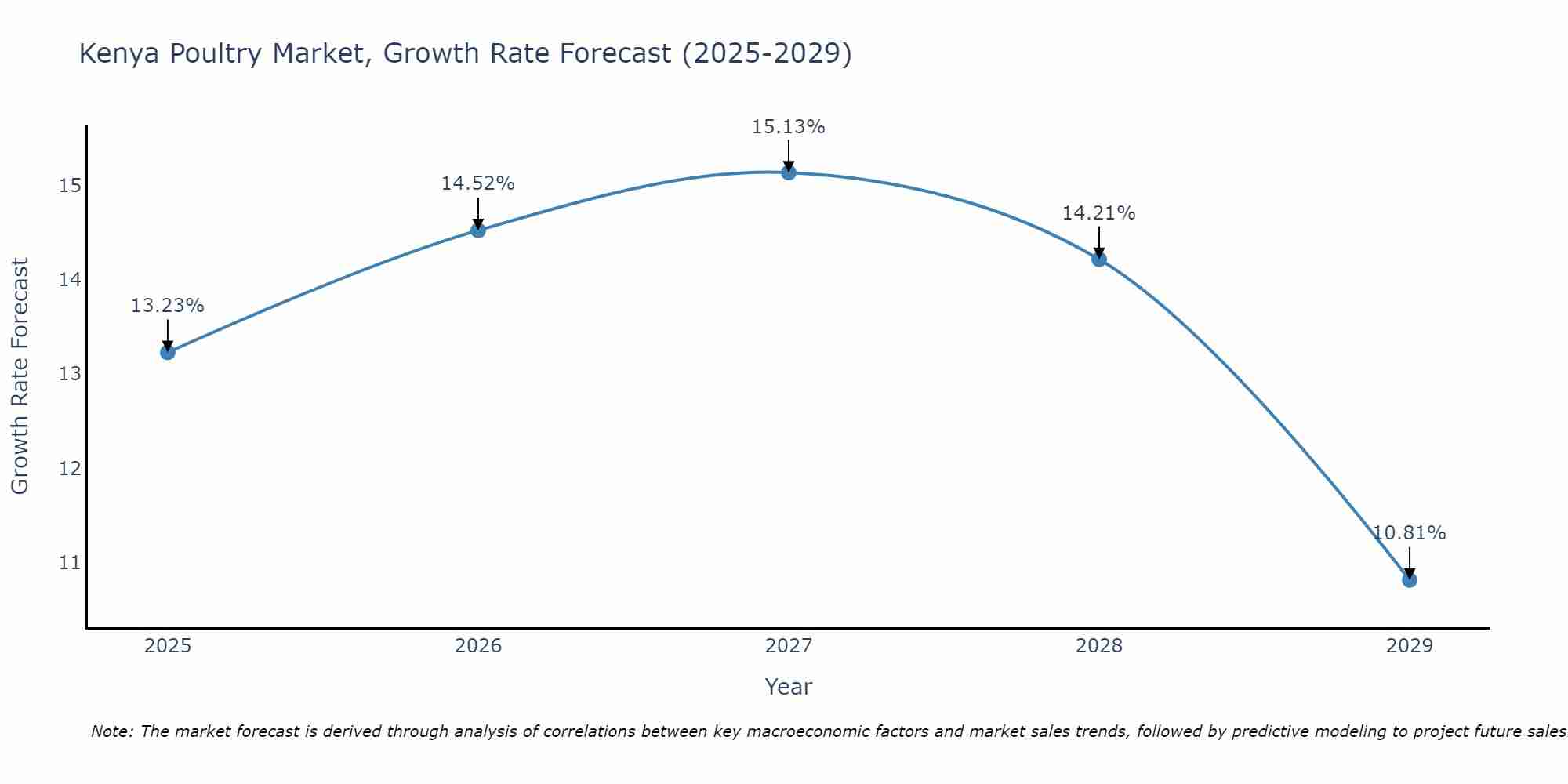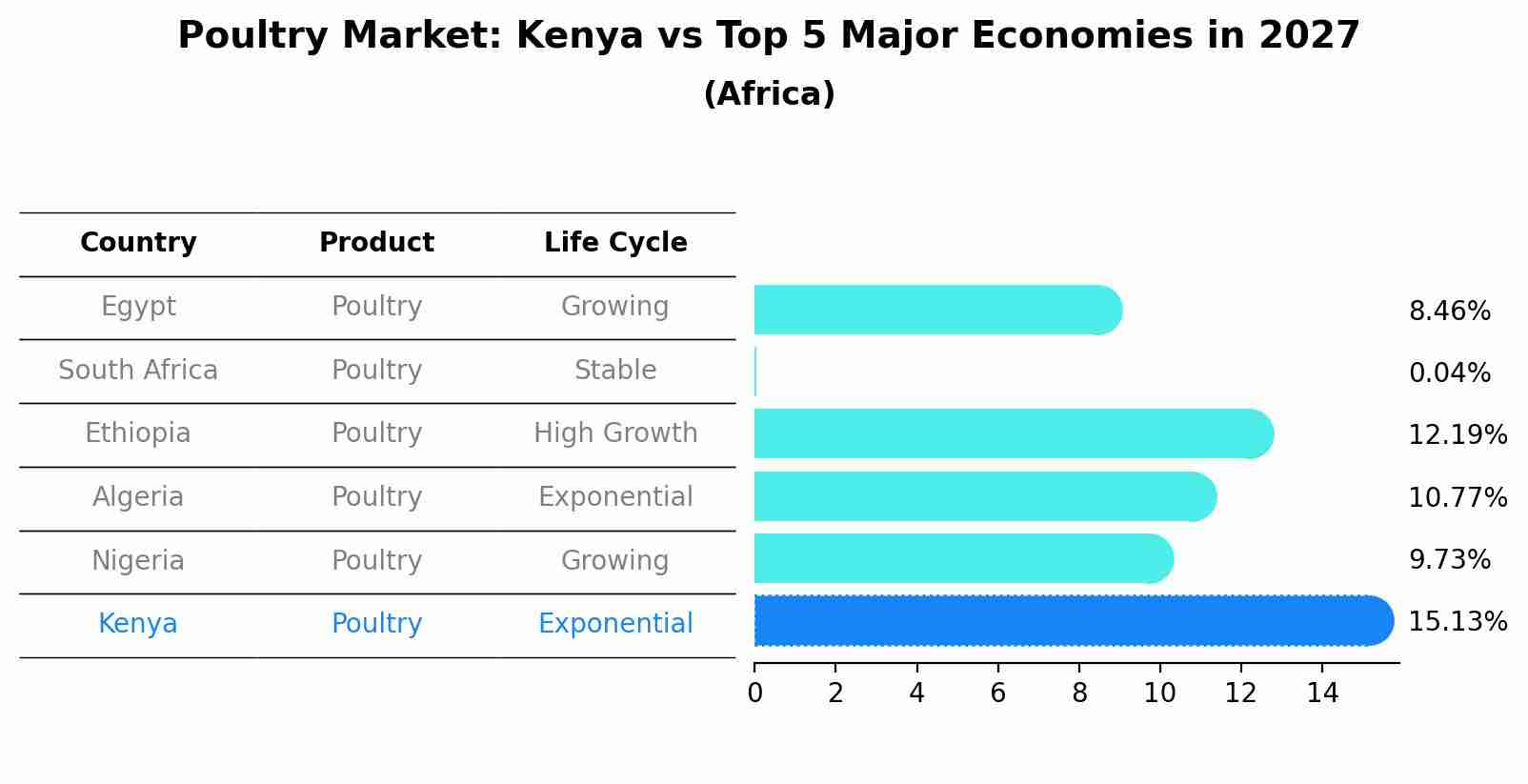Kenya Poultry Market Outlook | Growth, Companies, Industry, Revenue, Value, Share, Trends, Analysis, Forecast, COVID-19 IMPACT & Size
| Product Code: ETC384230 | Publication Date: Aug 2022 | Updated Date: Jul 2025 | Product Type: Market Research Report | |
| Publisher: 6Wresearch | Author: Bhawna Singh | No. of Pages: 75 | No. of Figures: 35 | No. of Tables: 20 |
Kenya Poultry Market Size Growth Rate
The Kenya Poultry Market is projected to witness mixed growth rate patterns during 2025 to 2029. Starting at 13.23% in 2025, the market peaks at 15.13% in 2027, and settles at 10.81% by 2029.

Poultry Market: Kenya vs Top 5 Major Economies in 2027 (Africa)
In the Africa region, the Poultry market in Kenya is projected to expand at a exponential growth rate of 15.13% by 2027. The largest economy is Egypt, followed by South Africa, Ethiopia, Algeria and Nigeria.

Kenya Poultry Market Synopsis
The Kenya poultry market is experiencing significant growth driven by increasing demand for poultry products such as eggs and chicken meat. Factors contributing to this growth include rising population, urbanization, and changing dietary preferences towards protein-rich foods. Small-scale poultry farming is prevalent in the country, providing livelihoods for many rural households. However, challenges such as disease outbreaks, high production costs, and limited access to quality feed and veterinary services hinder the industry`s full potential. To meet the growing demand, there is a trend towards commercialization and modernization of poultry farming practices, with an emphasis on improved genetics, biosecurity measures, and technology adoption. The market offers opportunities for investment in production, processing, and distribution to meet the increasing consumer needs for affordable and quality poultry products.
Kenya Poultry Market Trends
The Kenya poultry market is experiencing significant growth driven by increasing demand for poultry products such as eggs and meat. Consumers are increasingly seeking healthier protein sources, leading to a rise in poultry consumption. Additionally, the growing population and rising disposable incomes are contributing to the expanding market. There is a notable shift towards commercial poultry farming as more small-scale farmers embrace modern practices to meet the demand. Technological advancements in poultry farming, such as automated systems and biosecurity measures, are also gaining traction. However, challenges such as disease outbreaks and high production costs remain, prompting stakeholders to focus on improving efficiency and sustainability in the industry. Overall, the Kenya poultry market is poised for continued growth and innovation in the coming years.
Kenya Poultry Market Challenges
In the Kenya poultry market, challenges include disease outbreaks such as avian influenza, inadequate access to quality feeds and veterinary services, high production costs due to fluctuations in feed prices and lack of affordable credit for small-scale poultry farmers. Additionally, competition from cheap imports poses a threat to local producers, while inconsistent government policies and regulations create uncertainty in the market. Infrastructure issues like poor road networks also hinder the transportation of poultry products to markets, impacting profitability. Addressing these challenges requires investment in disease control measures, improving access to inputs and services, implementing supportive policies, and enhancing infrastructure to support the growth and sustainability of the Kenyan poultry industry.
Kenya Poultry Market Investment Opportunities
In the Kenya poultry market, there are several promising investment opportunities to explore. One area of growth is the production of value-added poultry products such as processed meats, sausages, and ready-to-eat meals, catering to the increasing demand for convenient and affordable protein sources among the urban population. Additionally, investing in modernizing poultry farming practices through technology adoption, biosecurity measures, and improved feed formulations can enhance productivity and profitability for both small-scale and large-scale poultry farmers. Another avenue for investment is in the development of poultry breeding and genetics to improve the quality and disease resistance of poultry stocks, ultimately leading to higher yields and better market competitiveness. Overall, the Kenya poultry market offers diverse opportunities for investors looking to capitalize on the country`s growing demand for poultry products.
Jordan Agar Market Government Policies
The Kenyan government has implemented various policies to support the poultry market, aimed at boosting production, ensuring food safety, and promoting the sector`s growth. Some key policies include the Poultry Policy Framework, which outlines strategies for disease control, breeding programs, and market access; the Poultry Sector Development Strategy, focusing on capacity building, technology transfer, and value addition; and the National Food Safety Policy, to ensure the quality and safety of poultry products. Additionally, the government has established regulatory bodies such as the Directorate of Veterinary Services and the Kenya Bureau of Standards to enforce standards and regulations in the poultry industry, enhancing consumer confidence and market competitiveness. Overall, these policies aim to create a conducive environment for sustainable growth and development of the Kenya poultry market.
Kenya Poultry Market Future Outlook
The Kenya poultry market is poised for significant growth in the coming years due to increasing urbanization, rising disposable incomes, and a growing population. The demand for poultry products, particularly chicken meat and eggs, is expected to rise as consumers seek affordable sources of protein. Additionally, the government`s efforts to promote poultry farming through initiatives such as subsidies, training programs, and improved infrastructure will further drive market expansion. Technological advancements, such as the adoption of automated systems and improved breeding techniques, are also expected to enhance productivity and efficiency in the poultry sector. Overall, the Kenya poultry market presents lucrative opportunities for investors and stakeholders looking to capitalize on the country`s evolving food and agriculture landscape.
Key Highlights of the Report:
- Kenya Poultry Market Outlook
- Market Size of Kenya Poultry Market, 2021
- Forecast of Kenya Poultry Market, 2031
- Historical Data and Forecast of Kenya Poultry Revenues & Volume for the Period 2018 - 2031
- Kenya Poultry Market Trend Evolution
- Kenya Poultry Market Drivers and Challenges
- Kenya Poultry Price Trends
- Kenya Poultry Porter's Five Forces
- Kenya Poultry Industry Life Cycle
- Historical Data and Forecast of Kenya Poultry Market Revenues & Volume By Segments for the Period 2018 - 2031
- Historical Data and Forecast of Kenya Poultry Market Revenues & Volume By Broiler for the Period 2018 - 2031
- Historical Data and Forecast of Kenya Poultry Market Revenues & Volume By Eggs for the Period 2018 - 2031
- Historical Data and Forecast of Kenya Poultry Market Revenues & Volume By End Uses for the Period 2018 - 2031
- Historical Data and Forecast of Kenya Poultry Market Revenues & Volume By Food Service for the Period 2018 - 2031
- Historical Data and Forecast of Kenya Poultry Market Revenues & Volume By Household for the Period 2018 - 2031
- Historical Data and Forecast of Kenya Poultry Market Revenues & Volume By Distribution Channels for the Period 2018 - 2031
- Historical Data and Forecast of Kenya Poultry Market Revenues & Volume By Traditional Retail Stores for the Period 2018 - 2031
- Historical Data and Forecast of Kenya Poultry Market Revenues & Volume By Business To Business for the Period 2018 - 2031
- Historical Data and Forecast of Kenya Poultry Market Revenues & Volume By Modern Retail Stores for the Period 2018 - 2031
- Kenya Poultry Import Export Trade Statistics
- Market Opportunity Assessment By Segments
- Market Opportunity Assessment By End Uses
- Market Opportunity Assessment By Distribution Channels
- Kenya Poultry Top Companies Market Share
- Kenya Poultry Competitive Benchmarking By Technical and Operational Parameters
- Kenya Poultry Company Profiles
- Kenya Poultry Key Strategic Recommendations
Frequently Asked Questions About the Market Study (FAQs):
- Single User License$ 1,995
- Department License$ 2,400
- Site License$ 3,120
- Global License$ 3,795
Search
Thought Leadership and Analyst Meet
Our Clients
Related Reports
- Germany Breakfast Food Market (2026-2032) | Industry, Share, Growth, Size, Companies, Value, Analysis, Revenue, Trends, Forecast & Outlook
- Australia Briquette Market (2025-2031) | Growth, Size, Revenue, Forecast, Analysis, Trends, Value, Share, Industry & Companies
- Vietnam System Integrator Market (2025-2031) | Size, Companies, Analysis, Industry, Value, Forecast, Growth, Trends, Revenue & Share
- ASEAN and Thailand Brain Health Supplements Market (2025-2031) | Strategy, Consumer Insights, Analysis, Investment Trends, Opportunities, Growth, Size, Share, Industry, Revenue, Segments, Value, Segmentation, Supply, Forecast, Restraints, Outlook, Competition, Drivers, Trends, Demand, Pricing Analysis, Competitive, Strategic Insights, Companies, Challenges
- ASEAN Bearings Market (2025-2031) | Strategy, Consumer Insights, Analysis, Investment Trends, Opportunities, Growth, Size, Share, Industry, Revenue, Segments, Value, Segmentation, Supply, Forecast, Restraints, Outlook, Competition, Drivers, Trends, Demand, Pricing Analysis, Competitive, Strategic Insights, Companies, Challenges
- Europe Flooring Market (2025-2031) | Outlook, Share, Industry, Trends, Forecast, Companies, Revenue, Size, Analysis, Growth & Value
- Saudi Arabia Manlift Market (2025-2031) | Outlook, Size, Growth, Trends, Companies, Industry, Revenue, Value, Share, Forecast & Analysis
- Uganda Excavator, Crane, and Wheel Loaders Market (2025-2031) | Strategy, Consumer Insights, Analysis, Investment Trends, Opportunities, Growth, Size, Share, Industry, Revenue, Segments, Value, Segmentation, Supply, Forecast, Restraints, Outlook, Competition, Drivers, Trends, Demand, Pricing Analysis, Competitive, Strategic Insights, Companies, Challenges
- Rwanda Excavator, Crane, and Wheel Loaders Market (2025-2031) | Strategy, Consumer Insights, Analysis, Investment Trends, Opportunities, Growth, Size, Share, Industry, Revenue, Segments, Value, Segmentation, Supply, Forecast, Restraints, Outlook, Competition, Drivers, Trends, Demand, Pricing Analysis, Competitive, Strategic Insights, Companies, Challenges
- Kenya Excavator, Crane, and Wheel Loaders Market (2025-2031) | Strategy, Consumer Insights, Analysis, Investment Trends, Opportunities, Growth, Size, Share, Industry, Revenue, Segments, Value, Segmentation, Supply, Forecast, Restraints, Outlook, Competition, Drivers, Trends, Demand, Pricing Analysis, Competitive, Strategic Insights, Companies, Challenges
Industry Events and Analyst Meet
Whitepaper
- Middle East & Africa Commercial Security Market Click here to view more.
- Middle East & Africa Fire Safety Systems & Equipment Market Click here to view more.
- GCC Drone Market Click here to view more.
- Middle East Lighting Fixture Market Click here to view more.
- GCC Physical & Perimeter Security Market Click here to view more.
6WResearch In News
- Doha a strategic location for EV manufacturing hub: IPA Qatar
- Demand for luxury TVs surging in the GCC, says Samsung
- Empowering Growth: The Thriving Journey of Bangladesh’s Cable Industry
- Demand for luxury TVs surging in the GCC, says Samsung
- Video call with a traditional healer? Once unthinkable, it’s now common in South Africa
- Intelligent Buildings To Smooth GCC’s Path To Net Zero


















